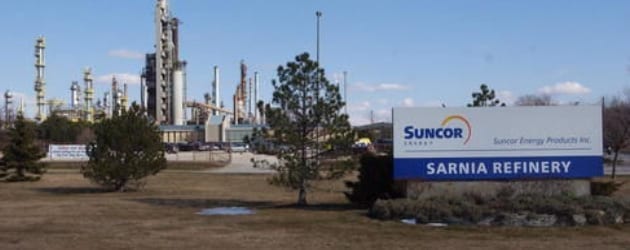Suncor Refinery

Location: Sarnia, Ontario
Owner/Operator: Suncor
Located by the St. Clair River, which runs along the border between Ontario, Canada and the U.S. state of Michigan, the Sarnia Refinery has been a significant producer of fuel since it began operation in 1953 processing 15,000 barrels of product a day. Today, the company takes feedstock from the province of Alberta in Western Canada, and the U.S. to process 85,000 barrels of crude oil a day and produces gasoline, kerosene, jet and diesel fuels, asphalt and petrochemical feedstock. It meets 15 per cent of Ontario’s refined product needs. In 2007, a major capital upgrade enabled the refinery to meet low sulphur fuel standards and integrate Canadian oil sands feedstock.
For more than a decade, HGC Engineering has been helping Suncor understand and manage its acoustic emissions. Starting in 2004, during the planning stages for a new plant at the refinery, we have been developing and refining an acoustic model of the facility, based on sound level measurements conducted throughout the refinery complex. Numerous assessment reports have been prepared, both for individual projects and additions at the refinery site, and for the refinery as a whole. Various efforts have been undertaken to investigate diurnal patterns in the background noise in the area around the refinery, and the effects of weather on sound propagation to neighbouring communities.
In 2005 we completed a predictive acoustic assessment of a proposed new major plant containing multiple process units within the refinery, in support of environmental approvals.
In 2007, the first site-wide acoustic assessment report was prepared based on the computational acoustic model developed by HGC Engineering based on comprehensive noise measurements made of individual sound sources within the refinery.
In 2012, we developed vibration criteria, and monitored construction vibration during vibratory sheet pile driving at a new river water intake facility.
From 2007 to the present, we have continued to develop the acoustical model as new equipment is added to the refinery.
Acoustical engineering services delivered included:
- Conducted detailed acoustical assessment reports and audits in accordance with Ontario Ministry of the Environment and Climate Change (MOECC) noise guidelines
- Environmental Noise Studies
- Developed a noise abatement action plan
- Comprehensive onsite acoustical measurements
- Predictive acoustical modeling
- Noise control recommendations
- Investigation of the relationship between offsite noise and weather patterns
- Vibration measurements and monitoring during vibratory sheet pile driving



